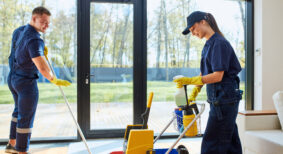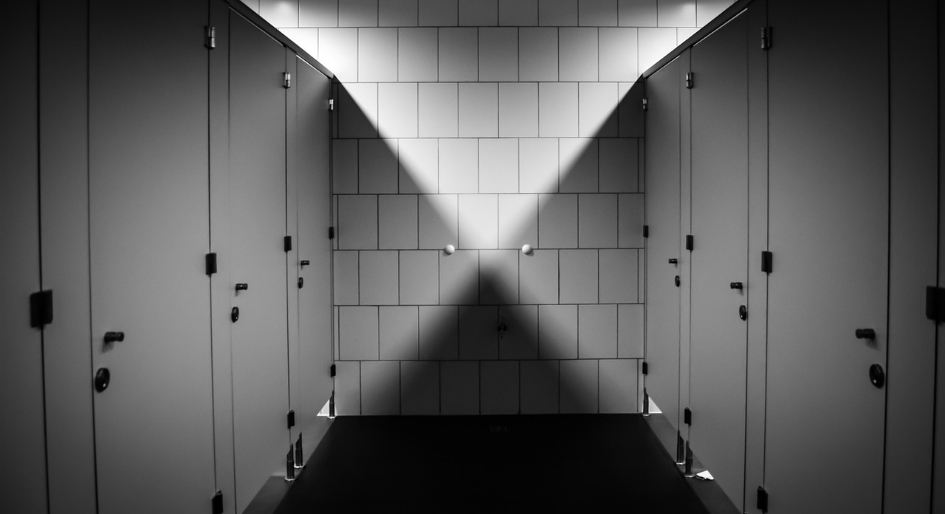When it comes to long-term cleanliness and safety, floors in a locker room are of upmost concern. This is especially true today, due to COVID-19. Pathogens on floors can spread to hands and from hands, to eyes, nose, and mouth, potentially spreading disease.
In a situation where a new locker room is being built or an older one is being renovated, make sure to select a floor with some “teeth” to it. Yes, you read that right – the floor should have some teeth.
This means the floor supplies enough traction that it helps reduce the possibility of a slip and fall accident. As we know, locker rooms are typically damp areas, and many today no longer have flow-thru mats to walk on, so this means those using the locker room are likely walking on a damp, if not wet, floor most of the time. When the floor surface has more teeth, it is more likely that locker room users will be able to walk around or come and go safely.
In order to get some teeth in the floor, administrators typically look to tiles that have some texture to them. This texture may often be the result of grooves worked into the tiles, complemented by the grouting. Grout serves many purposes for a locker room floor. First and most important, it holds the tiles in place. It also adds friction to the floor, which is one of our goals, and helps waterproof the floor so that moisture does not seep below the floor surface.
All this sounds well and good until it comes time to clean the floor. Let’s examine these grooves and grout a little closer. Both are just slightly below the surface of the floor. The good thing is that they help remove moisture from the floor’s surface, helping to promote safety. The bad thing – at least when it comes to cleaning – is that the moisture carries with it soils, soap, contaminants, and pathogens, which could include COVID pathogens. These all accumulate in the grooves and grout.
But grout is porous. View it as cement – in fact, it is a form of cement – with lots of tiny pores. All those soils and pathogens we just mentioned slowly seep into those pores. Because moisture and pathogens may be added to these areas daily, the pores rarely dry. And as we all know, one of the first requirements for germs, bacteria, mold, mildew, and other microorganisms to survive and thrive is moisture.
So now we have floors with teeth, which help prevent a slip and fall accident, but if we’re not careful, those teeth will bite, in the form of disease and odours. And if there is too much accumulation in the pores, as just discussed, the surface may even lose its slip-resistant qualities.
Why traditional cleaning methods don’t work
At this point, many administrators and housekeeping professionals are apt to be thinking, Well, just mop the floor. Or how about deck the floor down, hose it, then just let the floor air dry?
These are the traditional ways to clean a locker room floor, but just because they are the way floors have been cleaned for decades does not make them the most effective or efficient procedures. Let’s look at each a bit more closely.
Mopping: Fifteen years ago, a study called “Household Cleaning and Surface Disinfection: New Insights and Strategies” was published in the Journal of Hospital Infection. This study found that in situations where the cleaning procedure – referring to mopping floors – failed to thoroughly eliminate contamination on a floor surface it is often because “the contamination is transferred to that [new floor] surface” by the mop. What this means is that the mop and the mop water become soiled, and instead of removing contaminants, they are spreading them to new areas. What had been a localized soil is now spread over the entire surface.
And we should know there is even more going on that can be detrimental to the health of the floor. As that mop and mop water become soiled, the efficacy of the cleaning solution is weakened. What may have started out as a very powerful disinfectant is now whimpering along, losing its potency with every stroke of the mop.
Decking the floor down: This can prove much more effective. The “straws” of the deck brush can reach into the grout and tile pores and help remove contaminants. This is agitation, one of the four components of cleaning. But herein lies another problem. The deck brush does indeed stir things up and loosen soils, but does it actually remove them? No. We could squeegee the moisture and soils into floor drains but that will still likely leave some moisture and soils behind, starting a new generation of contaminants living in the floor pores. Essentially, we have taken two steps forward, but one big step back.
As to allowing the floor to air dry, that is very important no matter what new or old cleaning system is used. If moisture helps germs and bacteria survive and thrive, then the longer the floor areas are dry, the more likely the germs and bacteria will be eliminated. The problem is many locker rooms are used every day. For the floor and the pores to dry thoroughly, it may take two or three days.
Looking to alternatives
Let’s put on our thinking caps. We need some type of cleaning system that does not spread soils, one that provides the agitation to loosen and remove soils from tiles, grout, and the pores in the floor. And we need to find a way to totally remove the moisture and the soils from the floor.
Fortunately, coming up with a cleaning alternative does not require rocket science. On top of this, the professional cleaning industry has known for years, far longer than the study mentioned earlier, that we need a system to prevent mops from spreading soil from one surface to another.
The cleaning alternative to address this situation, now copied by a few manufacturers, is referred to as no-touch or spray-and-vac cleaning, a term coined by the ISSA.
First, these machines apply a cleaning solution to the floor. This loosens and dissolves soils. Next, the machine is used to pressure-rinse the floors. This provides the necessary agitation. Finally, the system is designed to vacuum up moisture, pathogens, etc. Now the vacuum has actually pulled them up and removed them from the floor, grout, and the pores.
Preventive Strategies
One more point to mention is that there are steps administrators can take to help protect locker room patrons and possibly keep floors healthier, at least for a while. Locker room mats are designed to allow moisture to seep below the floor surface. Many also have a slip-resistant surface to promote safety. Especially if using one of the traditional cleaning methods, mats should be considered because the floor may be more soiled than it appears.
Another thing to consider is sealing the grout. This may minimize its traction capabilities, but at least for a while it will help prevent moisture and soil from working their way into the pores. The problem is that in most cases the sealant slowly wears away, so view this as a temporary measure or one that should be repeated regularly.
Paul South is the president and general manager of Valley Janitorial, based in Hamilton, OH, a 30-year-old janitorial supply company.








